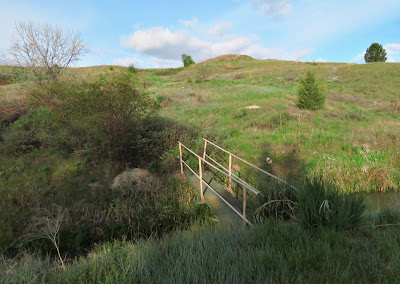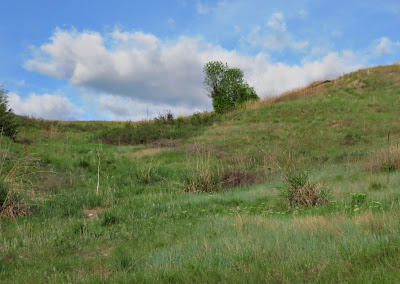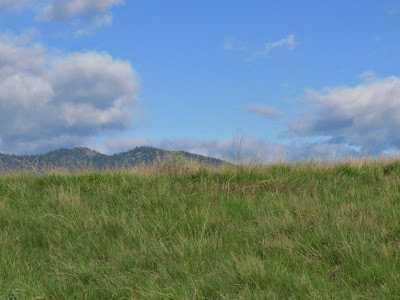Although Friday was supposed to be a rainy day, it dawned clear and I decided to take the auto tour. I thought I'd leave early, but found I hadn't plugged in my camera battery charger correctly so had to wait around for another hour until it charged. By this time it was 7:00 A.M. and the sun was already up. But since we are on the west side of the Mission Mountain Range, we don't get direct sunlight for a while longer. Clouds were already moving in, sometimes lightly covering the sun, so the light was still beautiful along the first several miles of the tour.
The auto tour road works its way up and down for a while, then goes up steeply through a series of switchbacks.In places, it is near the boundaries of the refuge and we get beautiful views out of the refuge. At the highest point, at the end of High Point Trail, at 4700 feet and some 2000 feet above headquarters, we can see a three hundred sixty degree panorama.
It took me four hours to do the first seven miles of the tour. Then I mostly just drove home, only stopping for big obvious things. The day got fully cloudy and I lost my light entirely. But this will be a place I'll go often. Yesterday, I saw my first lazuli bunting and took a picture of the first orange-crowned warbler I'd seen and heard singing. Both birds breed here along with the willow flycatcher, which I haven't seen yet. The spotted towees were also frequently singing - they just sing "teeeeeaaaaa" rather than the "Drink your teeaaa" the eastern towhees sing. I saw one Bullock's oriole but more will be showing up.
The tour starts with a right turn from the visitor center parking lot, goes north for a few hundred yards and then turns again and travels east for about a half mile as it starts to climb slightly. This gives wonderful views of the refuge, the Rattlesnake Mountain Range, and the Jocko River Valley.
There are some bluebird boxes near the beginning of the tour and we have breeding western and mountain bluebirds using them, as well as tree swallows. I didn't see any of them this day but will go out looking for them soon.
 |
| A wildflower I've yet to identify |
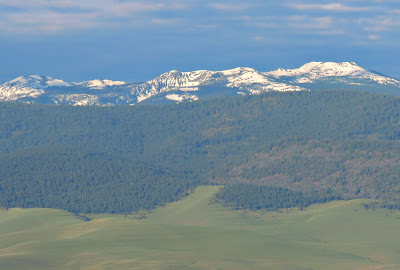 |
| A long view to the Rattlesnake Mountain Range |
 |
| View looking north up into the hills of the refuge |
 |
| Jocko River Valley with the Rattlesnake Mountains and storm clouds behind it |
As the road comes near the east side of the refuge, it makes a sharp turn and travels east along Pauline Creek for a mile or two. This is an intermittent creek, but has lots of little ring-fed pools along it and lots of bushes, including serviceberry and chokecherry, grow along it. So it attracts lots of wildlife and is the place to reliably find the lazuli bunting and the willow flycatcher, as well as Bullock's oriole, spotted towhees orange crowned warblers, and many other species of birds. Buffalo are in the far views along here and, when we cross the next cattle guard, they could be near the road.
 |
| One of a pair of mule deer bucks sleeping in near Pauline Creek |
 |
| Storm clouds forming over the Rattlesnake Range |
 |
| One of the hundred (thousands?) of western meadowlarks the refuge harbors |
 |
| View of the refuge lands north of the tour road |
 |
| South view down to a small pond along Pauline Creek which is hosting a pair of breeding mallards |
 |
| Beautiful fresh chokecherry blooms |
 |
| This bull bison was standing next to the road and eating dirt for its salts. |
 |
| Another beautiful wildflower that is just starting to bloom |
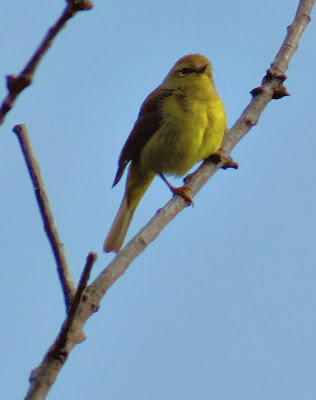 |
| An orange-crowned warbler between songs |
 |
| A kiting male kestrel shows off his beautiful rust body and blue wings |
The road leaves Pauline creek and starts to climb through a series of switchbacks. The long views are back to the east and the habitat changes to on of a forest for a very shorty while. I noticed I was running out of time and didn't stop as frequently or as long here. But this is the next area I really want to spend more time in. Right at the edge of this is is the first place you can take a little hike, the quarter-mile long Bitterroot trail. I'll be back just to find all the wildflowers here and to look for bears down in the valleys, or just back in the wooded area.
 |
| This bull liked the forest best |
 |
| As you climb, there are more and more beautiful long views |
 |
| View of one of the Rattlesnake Mountains from high up |
 |
| A long view way down into a valley from near Bitterroot trail |
 |
| Another little, yet unknown, wildflower |
 |
| One of the larkspurs |
By now, I officially thought of myself as just driving back but I had to stop a few times. The first big stop was at the place where High Point Trail intersects the road. The only bathrooms are here. And the view is across to the Mission Mountains. The sun was almost completely blocked by clouds, but occasionally a few rays made it out. From this point on, the trail goes downhill for the most part and sometimes very steeply. The next pictures are from these areas.
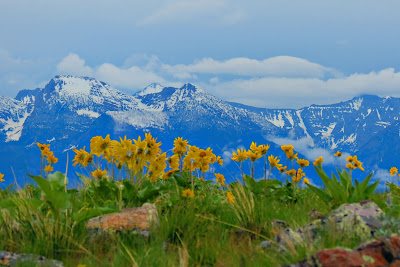 |
| View at the High Point Trail Interpretative Area |
 |
| This pronghorn male was a few miles away from the rest who mostly like the open plains further down |
 |
| A pair of Brewer's Blackbirds - the female is collecting nest material |
All of these pictures were taken in the first eight miles of the auto tour. The rest is both downhill and thrugh more plains until it runs along Mission Creek where there is another riparian area. The deer - white and mule are found along tere as are elk, and sometimes bear and bull bison, unless the main herd is in this pasture. I got here two days before the entire auto tour opened, so had only driven the last part of it, which is two-way during the winter. I wrote about that evening drive
here.











